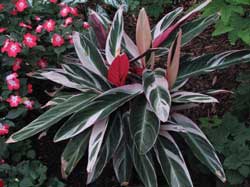Resource Library
Plant of the Week: Triostar (Tricolor)
The University of Arkansas System Division of Agriculture does not promote, support or recommend plants featured in "Plant of the Week." Please consult your local Extension office for plants suitable for your region.
Plant of the Week
[A-Z]
Tricolor
Latin: (Triostar) (Stromanthe sanguinea)

I write these columns because I want to learn more about the plants that surround me. One plant that I've had for years and never knew much about is one I call "Tricolor," a shorthand name used by greenhouse growers for this tough member of the prayer plant family.
The plant in question is a variegated selection of a tropical plant from Brazil called Stromanthe sanguinea. The correct cultivar name for this colorful cream, pink, green and maroon leafed plant is 'Triostar' but most American sources offer it as "Tricolor." The variegation pattern varies from leaf to leaf with some almost completely devoid of chlorophyll; some are half variegated while others have variegation patterns of various widths down the leaf. The backside of the leaf is a rich maroon with variegated portions a bright pink.
Tricolor is a frost-tender herbaceous perennial with short, creeping stems that can reach 5 feet tall in a tropical climate but usually is between 18 to 30 inches tall in containers or when used in the summertime garden. Most of the foliage arises from the crown of the plant with foot-long leaves produced at the ends of long petioles.
Between the leaf blade and the petiole is a swollen BB-sized lump called the pulvinus. Using a pair of specialized pigments (phytochrome and cryptochrome) that absorb only part of the light spectrum, the pulvinus helps orient the leaf according to the time of the day. At night, the leaf moves to an east-facing position to catch more of the early morning sun. As the day gets hotter, the pulvinus moves the leaf to an upright position so that the tip end of the leaf is exposed to the sun and the flat part of the leaf blade is protected.
Members of the prayer plant (maranta) family all have a strong family resemblance, but three species - the Calathea, the Ctenanthe and the Stromanthe - seem to cause much confusion. All are widely scattered throughout the jungles of South America, and the differences between the species is most easily seen when plants are flowering, something that doesn't occur with great regularity in the greenhouse. To add to the confusion¸ Ctenanthe oppenheimiana has a variegated clone called "Tricolor." Both "Tricolors" are very similar in appearance but C. oppenheimiana has thinner, wirier petioles than S. sanguinea.
The technical differences between various members of the maranta family may seem like a moot point to the average gardener, but the differences are important because there are big differences in the cultural requirements of the plants. Over the years, I've tried most of the common species of fancy leafed Calathea, but all have failed because I overwinter my tropicals in a cold greenhouse that routinely dips to 40 degrees Fahrenheit. They suffer whenever temperatures fall below 60.
But not so with Ctenanthe burle-marxii and Stromanthe sanguinea 'Tricolor,' the two showy calathea-like plants I grow. Both tolerate the cold greenhouse temperatures without complaint and then lavish in the summertime heat and humidity of my garden. Gardeners from California to Florida report both to be cold tolerant, surviving temperatures out of doors as low as 25.
Tricolor is recommended for shady sites, but it will tolerate full sun if planted where it gets plenty of water. I use mine as an accent plant in the shade garden; in subtropical regions where it can be grown out of doors it's used as a tall groundcover. If used as a houseplant, grow it in at least an 8-inch pot and give it bright light out of direct sun. It has good drought tolerance but if it gets too dry marginal leaf burn can occur. Propagation is by springtime division before new growth starts.
By: Gerald Klingaman, retired
Extension Horticulturist - Ornamentals
Extension News - September 26, 2008
The University of Arkansas System Division of Agriculture does not maintain lists of retail outlets where these plants can be purchased. Please check your local nursery or other retail outlets to ask about the availability of these plants for your growing area.